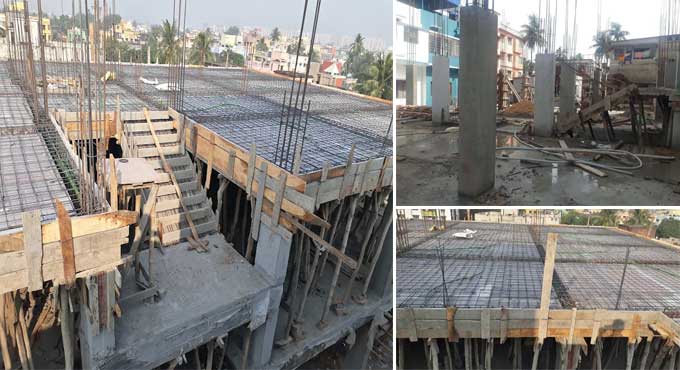NEWS | SOFTWARE | SHEET
Details of Reinforcement in Construction for Column, Beams and Slabs
Construction of buildings is mostly done with reinforced cement concrete, also known as RCC. In contrast to plain concrete columns, RCC columns are always advised over plain concrete columns since they are stronger when compressed.
Steel can withstand loads that are a couple of times that of concrete. Compared to RCC columns, plain concrete columns require a large area. An RCC column will have a much thinner section than plain concrete with a certain load. The RCC column can thus save a lot of space because it has a smaller size.
Regardless of whether a column is required to carry a load, a minimum area of steel is always provided. Tensile stresses caused by eccentric loads can be avoided using this method.
Importance of Column & Beam Reinforcement
Steel and concrete are the main components of RCC structures that handle loads. Structures are subject to bending moments, shear forces, and sometimes torsion due to external forces. The properties of concrete make it good in compression, but they make it weak in tension.
RCC structures are reinforced with steel to withstand the forces exerted on them by tensile forces. Primary longitudinal reinforcement is found in beams and columns, while secondary lateral reinforcement is found in columns. During construction, primary reinforcement is used to take on loads, whereas secondary reinforcement is used to prevent buckling.
Reinforcement details of Column
The number of bars should be six for circular sections. Concrete should have a minimum of 40 millimeters above the bar diameter in order to be workable.
There shall be no reinforcement greater than six percent of the concrete's gross area in any structure. A structural part should have a minimum reinforcement of less than one percent of its gross sectional area.
It is recommended that rectangular structures have at least four bars. A minimum of 12 millimeters should be used for primary reinforcement.
If lateral ties are less than 5 millimeters in diameter, they should not be less than a quarter the diameter of the largest longitudinal bar. The longitudinal reinforcement should be spaced no more than 300 millimeters apart while using helical ties. There should be a maximum pitch of 75 millimeters for helical reinforcement & a minimum pitch of 25mm.
Reinforcement Beam Details
For that section, there should be at least a 25 millimeter cover or the maximum diameter of steel used. Tension and longitudinal compression reinforcement are provided. For counteracting shear stresses, vertical stirrups and bent longitudinal bars are provided.
If a beam's web depth exceeds 750 millimeters, side face reinforcement bars are provided.
A suitable cover should be provided to prevent corrosion in beams. If the web thickness is less than 300mm, distribute .1 percent of the web area equally between both faces.
Reinforcement Types
Transverse Reinforcement
Transverse steels serve three purposes: To hold longitudinal bars in place, to prevent buckling of main longitudinal bars, and to resist diagonal tension caused by transverse shear due to any moment or load.
By confining concrete in the core, the column will be more ductile, and the longitudinal splitting of concrete will be prevented. Tie spirals enclosing the main steel provide transverse reinforcement of the column in the lateral direction.
Longitudinal Reinforcement
Longitudinal reinforcement is made up of steel bars placed longitudinally in a column & it is also known as main steel. The column is ductile because it resists tensile stresses caused by moments or accidental eccentricities.
To get more details, go through the following video tutorial.
Lecturer: Renu Singh
As a result, it reduces creep and shrinkage that may occur over time due to continuous constant loading. In addition to sharing the compressive loads with concrete, longitudinal reinforcement reduces the overall size of the column, thereby making the space more usable.
Bar Bending Schedule
Engineers and contractors should have enough information on the drawing to undertake work at the site. To get the cutting length of bars, their number, position, and shape, a bar bending schedule must be developed before the cutting begins.


